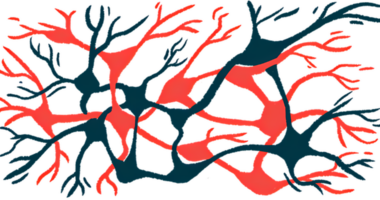Blocking 2 Proteins Might Stop Spread of Alpha-synuclein in Brain

The spread of alpha-synuclein aggregates in the brain is dependent on a protein receptor called TLR2, and also a transcription factor called NF-KB, a study indicates.
Blocking these proteins — which may be done with medications inhaled through the nose — may be a useful therapeutic approach in Parkinson’s disease and other conditions characterized by alpha-synuclein aggregates, its findings suggest.
The study, “Selective targeting of the TLR2/MyD88/NF-κB pathway reduces α-synuclein spreading in vitro and in vivo,” was published in Nature Communications.
One of the hallmark molecular features of Parkinson’s disease is the formation of aggregates (clumps) of the protein alpha-synuclein in the brain. These clumps are thought to drive brain cell death in Parkinson’s and its related disorders, Lewy body dementia and multiple system atrophy.
Alpha-synuclein aggregates are known to spread in the brain — that is, the protein clumps forming in one brain cell can prompt similar clumps in neighboring cells. However, the mechanisms that drive this spread are not understood.
“Understanding how these diseases work is important to developing effective drugs that inhibit alpha-synuclein pathology, protect the brain, and stop the progression of” diseases driven by alpha-synuclein, Kalipada Pahan, PhD, a professor at Rush University Medical Center and study author, said in a press release.
Pahan and other scientists at Rush demonstrate in this study that alpha-synuclein clumps activate a receptor protein called TLR2 on microglia, a type of resident immune cell in the brain.
When TLR2 is activated in this way, it binds to another protein, called MyD88, to send signals into the cell. The researchers showed that blocking the interaction between TLR2 and MyD88 — by administering a short molecule that mimics the region where these two proteins normally interact, called wtTIDM — could stop the alpha-synuclein-induced activation of TLR2.
Further analyses showed that, when TLR2 is activated, it prompted the microglia to secrete certain inflammatory signaling molecules called cytokines. These cytokines, in turn, triggered neurons (nerve cells) to make more alpha-synuclein by activating a protein called NF-KB.
NF-KB is a transcription factor, a protein that regulates how genes, including the gene that encodes the alpha-synuclein protein, are “read” by the cell. The researchers showed that increasing NF-KB levels in neurons triggered greater alpha-synuclein production, indicating that “activation of [NF-KB] is sufficient to increase the expression of [alpha-synuclein] in neurons,” they wrote.
“We delineated that [alpha-synuclein]-induced activation of the TLR2-MyD88 pathway triggered the induction of inflammation and generation of proinflammatory molecules from microglia to further act on neurons and augment endogenous [alpha-synuclein] expression via [NF-KB]-dependent transcription, ultimately augmenting [alpha-synuclein] pathology [disease] in multiple regions of the brain” the researchers concluded.
Collectively, these results suggest that blocking TLR2 and/or NK-KB may prevent the spread of alpha-synuclein in the brain.
Experiments in a mouse model further supported this idea. When mice were treated intranasally with wtTIDM or NBD (an inhibitor of NF-KB), the spread of alpha-synuclein in their brains was significantly reduced, and Parkinson’s-like symptoms were markedly eased.
“These results suggest that wtTIDM and wtNBD … may be used for therapeutic intervention in PD [Parkinson’s disease]” and like disorders, the researchers wrote.
“If these results can be replicated in patients, it would be a remarkable advance in the treatment of devastating neurological disorders,” Pahan said.






